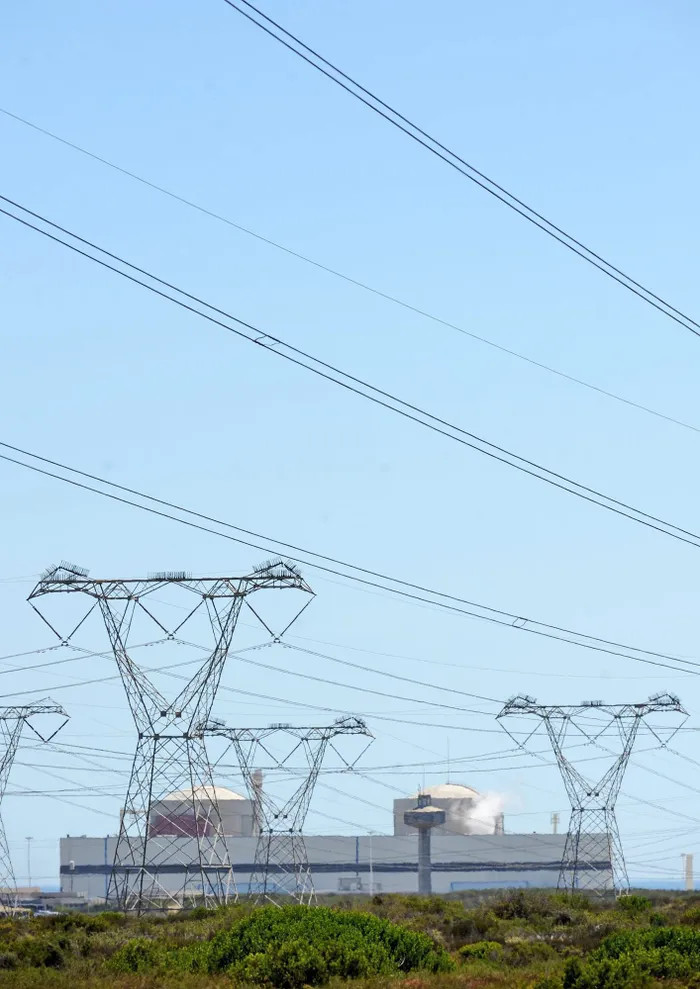The role and future of nuclear power in South Africa

Koeberg Nuclear Power Station. Nationally, nuclear energy has contributed approximately 5% to 6% of total electricity generation capacity.
Image: David Ritchie/Independent Newspapers
South Africa has been a nuclear power since as far back as 1984 - 1985, when the first unit of the two-unit Koeberg Nuclear Power Station was commissioned. Over the years, nuclear-generated electricity has served the country well, providing a stable and secure supply to the Western Cape for over four decades.
Nationally, nuclear energy has contributed approximately 5% to 6% of total electricity generation capacity. Importantly, in Koeberg’s nearly 40-year operational history, there has been no major nuclear incident, with the sole exception being the well-documented “bolt incident” nearly 20 years ago. A bolt was inadvertently dropped inside the generator during maintenance. The damage caused by the loose bolt meant that two huge sections of the generator – the rotor and the stator – had to be replaced. Apart from this, Koeberg has operated safely, consistently supplying electricity to the Western Cape, supported by other Eskom assets in the region.
Around 2008, Eskom recognised the looming threat of power shortages and initiated plans to expand nuclear generation. At the time, Eskom's financial position was strong, allowing it to embark on a nuclear expansion programme. Vendors were shortlisted, including Westinghouse (US) and Framatome (France). However, both bids were deemed prohibitively expensive, largely because Eskom planned to procure only one or two units, making economies of scale impossible. Mobilising equipment and infrastructure for such a small number of units, including overseas transport of large components, would have been financially unsustainable. Consequently, the process was shelved.
The initiative was revived in 2010–2011 under President Zuma’s administration. Following the release of the Integrated Resource Plan (IRP), which determined that 9.6 GW of new nuclear capacity was required, preparatory activities began. Numerous international stakeholders expressed interest, and benchmarking visits were undertaken. As a representative of the National Nuclear Regulator (NNR), I was involved in comprehensive assessments, aligned with the IAEA's Milestones Approach. These included evaluating safety standards, international safeguards compliance, and legislative adequacy for nuclear trade. South Africa subsequently signed nuclear cooperation agreements with France, South Korea, Japan, the United States, and others.
Despite this substantial effort, the programme was halted following a successful legal challenge. The courts ruled that due process had not been followed, particularly with regard to public consultation and parliamentary oversight of international agreements.
Let us not forget South Africa’s ambitious Pebble Bed Modular Reactor (PBMR) project. This initiative, launched in the early 2000s, sought to develop a small, inherently safe, high-temperature gas-cooled reactor based on improved German technology. The North-West University, then known as the Potchefstroom University for Christian Higher Education, played a central role in the engineering and R&D, housing experimental facilities and producing a new generation of nuclear engineers and researchers.
Initially, the PBMR design targeted 268 MW thermal output, which was later scaled up to 400 MW, requiring significant reengineering. However, the project struggled with leadership indecision and unclear goals. It was unclear whether it was intended solely for electricity generation or for broader industrial applications, such as high-temperature process heat for petrochemical production. While companies like Sasol showed interest in such applications, growing financial concerns and a change in political leadership saw the project mothballed shortly after President Thabo Mbeki left office.
I raise the PBMR example because one of South Africa’s viable future options is the deployment of small modular reactors (SMRs), a direction strongly supported by the Minister of Electricity. Globally, SMRs are gaining traction due to several advantages: they are modular, scalable, and can be constructed in phases—allowing initial electricity generation while additional units are brought online. Their compact designs mean reduced emergency planning zones and minimal land use disruption. SMRs prioritise fuel confinement rather than large containment structures, and many components can be factory-built and transported for on-site assembly—stimulating local manufacturing and job creation.
Internationally, countries with limited transmission infrastructure, such as Ghana and Kenya, view SMRs as practical solutions. In South Africa, SMRs - particularly high-temperature gas-cooled reactors like the PBMR - could replace ageing coal-fired plants scheduled for decommissioning post-2026 due to environmental commitments under the Paris Agreement.
Technologically, coal and nuclear plants share similar infrastructure: turbine systems, generators, and switchgear - differing only in heat source. Retrofitting existing coal sites with nuclear reactors could thus preserve jobs and revitalise local economies.
This is not merely theoretical. TerraPower, a nuclear company backed by Bill Gates, is constructing a 300 MW SMR in Kemmerer, Wyoming, US, on the site of a former coal plant. The project demonstrates the feasibility of repurposing coal infrastructure for nuclear power.
As South Africa contemplates its own nuclear renaissance, certain prerequisites must be addressed:
Skills Development: South Africa has a strong pool of nuclear professionals, many trained during the PBMR era, with many expressing willingness to return. The North-West University remains the only South African university offering Master's and PhD programmes in nuclear engineering. Continued investment in higher education and vocational training (e.g., welding, millwrighting) is essential.
Industrial Readiness: While South Africa has significant engineering capacity, nuclear projects require specialised skills and rigorous quality standards. Collaborations with experienced international firms will be vital.
Regulatory Framework: The National Nuclear Regulator has a robust licensing system in place and maintains strong ties with the International Atomic Energy Agency, complying with international obligations, including the Additional Protocol and the Convention on the Physical Protection of Nuclear Material.
Financing: The most significant challenge is funding. Encouragingly, the World Bank and the European Central Bank have recently lifted restrictions on funding nuclear projects, recognising nuclear energy as a low-carbon solution. The Department of Mineral Resources and Energy has explored various financing models, which now need to be carefully weighed against national priorities.
In conclusion, if managed with care, transparency, and strategic foresight, nuclear power can play a central role in South Africa’s energy security, job creation, and industrial revitalisation. The pathway is viable, now it requires leadership, vision, and national commitment.

Professor Bismark Tyobeka is the principal and vice-chancellor of the North-West University.
Image: Supplied
Professor Bismark Tyobeka is the principal and vice-chancellor of the North-West University (NWU), former CEO of the National Nuclear Regulator, and has recently been appointed both a member and chairperson of the Ministerial Expert Panel on Nuclear.
*** The views expressed here do not necessarily represent those of Independent Media or IOL
BUSINESS REPORT